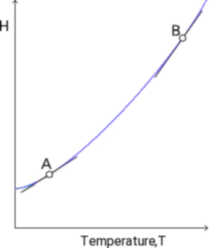Heat Capacity
We cannot measure the absolute 'total' internal energy of a body. We can only measure the change in its internal energy. The internal energy of a substance increases when its temperature is raised. The increase depends on the conditions under which the heating takes place. The heat capacity is defined as
C = δq/dT
when a system absorbs a quantity δq of heat its temperature increases by dT. The heat capacity of a system containing one mole is known as molar heat capacity and indicated by c. The heat capacity, C of a system containing n moles is thus C = nc.
Heat capacities are extensive properties: 100 g of water, for instance, has 100 times the heat capacity of 1 g of water (and therefore requires 100 times the energy as heat to bring about the same rise in temperature). The specific heat capacity, Cs, is defined as the heat capacity per unit of mass. The SI unit of measurament for specific heat capacity is the j/kg⋅K. Thespecific heat capacity of water at room temperature is close to 4 JK−1 g−1. If we wish to calculate the variation of internal energy we use the following relation
ΔU = m ⋅ Cs (Tfinal − Tinitial)
The heat capacity at constant volume, denoted by CV is defined as
CV = (∂q/∂T)V
since δq = dU at constant volume, we may write
CV = (∂U/∂T)V (2.0)
The molar heat capacity at constant volume, CV,m, is the heat capacity per mole of material; it is an intensive property.
Heat Capacity at Constant Pressure
For processes at constant pressure we have δqP = dH; We define the heat capacity at constant pressure, CP as
CP = (∂H/∂T)P (2.1)

The enthalpy of a substance increases as its temperature is raised. The variation of CP and CV with temperature can be ignored and heat capacities considered constants only for restricted intervals of T.
For condensed phases CP ≌ CV, whilst for gas phases there is a considerable difference.
When a gas is heated at constant pressure, the system can do work, and thus more energy is required to cause the same increase of temperature. Consequently Cp > CV.
Cv of a perfect gas
The ideal gas model requires the gas to satisfy the following conditions
PV = nRT
(∂U/∂V)T = 0 (2.2) absence of interaction forces.
(∂H/∂P)T = 0 (2.3)
Though the last two requirements are included in the equation of state.
The total differential of U = f(V,T) is
dU = (∂U/∂V)T dV + (∂U/∂T)V dT
From (2.0) and (2.2), we obtain
dU = CV dT (2.4)
In fact (2.2) states that U is a function of T only U = f(T). Eq (2.4) is true only for ideal gases and has not to be confused with equation (2.0) applicable to all system at constant V.
The heat capacity of a monatomic perfect gas can be calculated by inserting the expression for the internal energy derived from the equipartition theorem of classical mechanics.
U(T) = U(0) + 3/2 ⋅ nRT (2.3)
The derivative with respect to temperature of U at constant volulme is thus
CV = (∂U/∂T)V = 3/2 ⋅ nR
The molar heat capacity is a constant, CV,m = 3/2 R, for all monoatomic perfect gases so the internal energy increases linearly with temperature.
Cp of a perfect gas
For a perfect gas, H = U + PV = U + nRT. Hence (2.3) shows that H depends only on T for a perfect gas. Using CP = (∂H/∂T)P, we then have
H = H(T), CP = (∂H/∂T)P, CP = CP(T) perf.gas
If we write the total differential of H = f(P,T)
dH = (∂H/∂P)T dP + (∂H/∂T)V dT
From (2.3) we have
dH = CP dT
Again this equation holds tre only for perfect gas and has not to be confused with equation (2.1) valid for all systems.
The derivation of Cp is not simple, but for a perfect gas we can derive Cp from CV. The variation on internal energy dU is the same because fro the processes at constant pressure or volume because for a perfect gas U is only a function of T.
The work PdV done by the gas during the transformation at constant P can be related to the variation of temperature by differentiating the equation of state of the perfect gas
PdV + VdP = nRdT
VdP = 0 for a transformation at constant P, thus
pdV = nRdT (for a transformation at costant P)
If we replace eq (2.2) and pdV in the first law of thermodynamics δq = dU + pdV, we obtain
δq = CvdT + nRdT
Since δq = CpdT for the transformation at constant P, we have
CpdT = CvdT + nRdT
We can solve for Cp and obtain
Cp = CV + nR
and we obtain again the result Cp > CV. By knowing CV we are now able to calculate Cp.